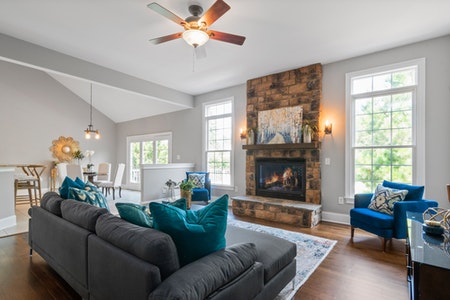If you happen to be wondering what open-plan living means, wonder no more as you’re about to get a detailed explanation on this free-flowing use of living space as well as the pros and the cons.

Open plan living refers to wide-open spaces in the home. Instead of the barriers which separate the living room, kitchen, dining room etc. in the home, an open plan living removes such barriers and makes for more space within the home. Since there are no restrictions (barriers), this allows for better ventilation, and inflow of enough light in the home. This is going to be of a better relief during the hot seasons.
Open plan living has its pros and cons. In this article, you’re about to find out whether open plan living is just right for you. Keep reading on.

Benefits Of Open Plan Living
1. Enough airflow and natural light: Since there are no walls and doors to act as barricades, you can expect enough air inflow and natural light into the house.
2. Attractive interiors: It creates a beautiful and easy view from the front of the house to the back. This type of system allows for flexibility and dynamism, as it allows you to shift your furniture and different interior items to wherever you want in your home. You can decide to switch the position of your dining area and your living room.
3. Shared family spaces:Sometimes, it is not easy for modern families to spend some time together as everyone becomes busy with their different schedules and barriers such as walls and doors make it even more difficult to unite. But with the system of an open plan living, even if everyone is involved in their different activities, there is still a sense of unity. Also, being able to relax and cool off in the same space brings about a sense of togetherness.
4.There is space for entertainment: If you’re the type that loves parties and a get-together, then the open plan living is for you. The open plan living provides an enabling environment for entertainment as you can easily host friends in the open space. However, an open plan living is not for everyone. It is left to you to decide if this kind of lifestyle suits you.

Cons of Open Plan Living
1. No privacy: If you’re the type who loves a private life, then this system isn’t for you. It is difficult to have access to private life as the whole room remains open. If you love being alone, then you may need to reconsider if you can cope with this kind of system.
2. A messy kitchen is always seen: The kitchen is mostly always the messiest area in the house. Using the system of open plan living involves constant cleaning of the kitchen as visitors can come visiting and notice the mess easily and this doesn’t speak well. Using this kind of system, you constantly have to clean up as you use the kitchen.
3. No easy way to contain the mess: Sometimes you may want to quickly rest a bit or catch your breath for a while. This system doesn’t allow you that. You may even be in debt and trying to hide from your creditor when your creditor comes knocking. But with this system, it becomes difficult (Don’t go about owing people).
4. Expensive to heat and cool: Conventional floor planning allows you to heat or cool a particular room at once, but this is not possible in an open plan living as the whole room or house will be heated or cooled.

How to Heat Open Plan Living
1. Close and sheathe: Sealing of cracks in the home’s enclosure and modifying sheathe are important energy-efficient measures no matter your preference for a particular home style.
2. Complement your primary source of heating: Members of the same family have this tendency to stay together in one cosy corner. Even if you have a very large open area measuring several thousands of feet, there are still some spots whereby family members love to stay together. Those particular spots could be heated to provide the needed warmth.
3. Warming the floor: Radiant underground heating is highly recommended. When building a new house or modifying an existing house, underground heating can be added to provide warmth. The floor can be covered with a thick carpet or rug to add warmth.
4. Through the use of heat pumps: Heat pumps turn cool air to warm air and warm air to cool air through the help of a refrigerant. Geothermal heat source uses the heat stored underground in the heating process. In situations where there are no adverse weather changes, then a heat pump will be perfect to have in an open plan living environment.
Modern indoor design trends are shifting towards open plan living system, you see it every day on property TV shows.
If you want to construct or make changes to your existing building, you may want to consider having an open plan living environment. You should however consider the upsides as well as the downsides before you make your decision.
Whatever your decision is, just make sure you know what’s best for you.

